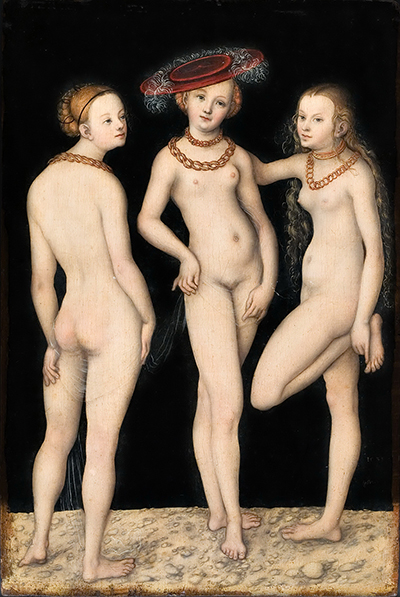Three Graces by Lucas signify epitomes of exquisiteness, charm, and elegance. Bestowing to Earliest Greek folklore, they represent the daughters of Zeus and the Oceanid. The three holy sisters were entourages of the goddess Aphrodite and were part of her servants.
Lucas Cranach the Elder was a German Resurgence watercolorist and printmaker in carving and linocut. He was courtyard artist to the Constituents of Saxony for most of his profession and is recognized for his depictions, both of German doyens and those of the front-runners of the Protestant Overhaul, whose foundation he hugged with eagerness. He was a handy colleague of Martin Luther.
Lucas was born at Kronach in central Germany and his precise date of birth is anonymous. He cultured the art of illustration from his dad Hans Maler who was a painter. How Cranach obtains basic education is unknown but it was undoubtedly with indigenous south German teachers. Bestowing to Gunderam, Cranach verified his aptitudes as a watercolorist before the end of the 15th century. His artwork depicted the devotion of Duke Frederick III who devoted Cranach to his courtyard in the year 1504. Cranach also coated religious themes, primarily in the Catholic custom, and later vexing to treasure new ways of carrying Lutheran devout disquiets in art. This sharpened his artistic journey. He was persistent during the course of his career to daub nude issues drawn from folklore and belief. Among his many amazing artworks, Lucas Cranach has received lots of appreciation for the three Graces portrait.
The technique applied by Lucas Cranach was oil on canvas. Oil on canvas is the route of water coloring with dyes with a mediocre of drying oil as the ring binder. Frequently used drying oils consist of linseed oil, poppy oil, walnut oil, in addition to safflower oil. The selection of oil conveys a series of chattels to the oil tint, such as the quantity of staining or dehydrating time. Assured modifications, liable on the oil, are similarly noticeable in the luster of the paints. A painter might use more than a few diverse oils in the matching painting contingent on explicit pigments and special effects anticipated. The shades themselves beside ripen a precise reliability subject on the medium. The lubricant may be simmered with a resin, such as yearn resin to generate a glaze high-quality for its body and sheen. Old oil painting skills habitually begin with the painter outlining the focus onto the canvas with watery paint. Oil paint is customarily mixed with linseed oil or other diluters to make the paint turpentine.




